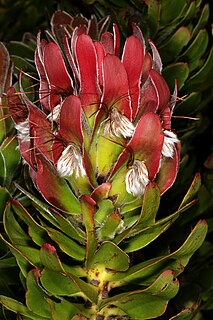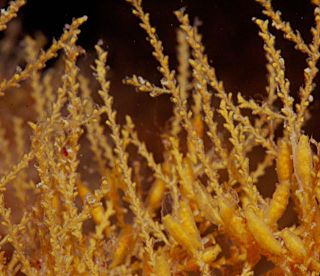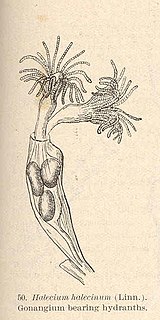Clinus brevicristatus, the Cape klipfish, is a species of clinid that occurs in subtropical waters of the Atlantic Ocean around South Africa where it prefers habitats with plentiful growth of seaweed. This species can reach a maximum length of 12 centimetres (4.7 in) TL.

Mimetes fimbriifolius, also called cowl pagoda or the fringed pagoda, is a species of plant in the family Proteaceae. It is a dense, rounded, multi-branched tree that grows up to 4 metres in height. This attractive and striking plant flowers all year round, and produces red and yellow branch-heads and inflorescences. The nectar-rich flowers are pollinated by sunbirds and the seeds are distributed and taken underground by ants before germinating. It is endemic to the Table Mountain range in the city of Cape Town, South Africa.

Bougainvillia muscus is a marine invertebrate, a species of hydroid in the suborder Anthomedusae.

Coryne eximia is a species of athecate hydroid belonging to the family Corynidae.

Eudendrium ramosum, sometimes known as the tree hydroid, is a marine species of cnidaria, a hydroid (Hydrozoa) in the family Eudendriidae of the order Anthoathecata.

Obelia longissima is a colonial species of hydrozoan in the order Leptomedusae. Its hydroid form grows as feathery stems resembling seaweed from a basal stolon. It is found in many temperate and cold seas world-wide but is absent from the tropics.

Hydroids are a life stage for most animals of the class Hydrozoa, small predators related to jellyfish.

Solanderia is the sole genus of hydrozoans in the monotypic family Solanderiidae. They are commonly known as tree hydroids or sea fan hydroids.

Thuiaria articulata, the jointed hydroid or sea spleenwort, is a branching colonial hydroid in the family Sertulariidae.

The planar hydroid is a branching colonial hydroid in the family Sertulariidae.

Corhiza scotiae, the fine hydroid, is a delicate colonial hydroid in the family Halopterididae.

Gattya humilis, the snowdrop hydroid, is a delicate colonial hydroid in the family Halopterididae.

Pycnotheca mirabilis, The feathery hydroid, is a colonial hydroid in the family Kirchenpaueriidae. Feathery hydroids are often white and grow in crowded colonies resembling upright feathers. The stems may grow to 3 cm in total height. The reproductive bodies are found at the base of the stems and resemble beehives.

Plumularia setacea, the plumed hydroid or little sea bristle, is a colonial hydrozoan in the family Plumulariidae and is found worldwide. It lives from the shore to 430m under water.

Aglaophenia pluma, the toothed feather hydroid or podded hydroid, is a colonial hydroid in the family Aglaopheniidae and is found worldwide. It lives from the shore to 120m under water.

Macrorhynchia filamentosa, the smoky feather hydroid, is a colonial hydroid in the family Aglaopheniidae.
Solanderia ericopsis is a hydroid in the family Solanderiidae, the group commonly known as tree hydroids or sea fan hydroids. S. ericopsis forms very large, conspicuous colonies from 5 to 50 cm in height, which are often noted by divers. They are usually strictly fan-shaped but can sometimes be bushy.

Sertularella polyzonias is a branching colonial hydroid in the family Sertulariidae.

Halecium muricatum, commonly known as the sea hedgehog hydroid, is a species of hydrozoan in the family Haleciidae. It occurs mainly in arctic and northern temperate waters, in both the Atlantic and Pacific Oceans.

Halecium halecinum, commonly known as the herring-bone hydroid, is a species of hydrozoan in the family Haleciidae. It is native to the eastern Atlantic Ocean, the western Atlantic Ocean and the eastern Pacific Ocean.



















